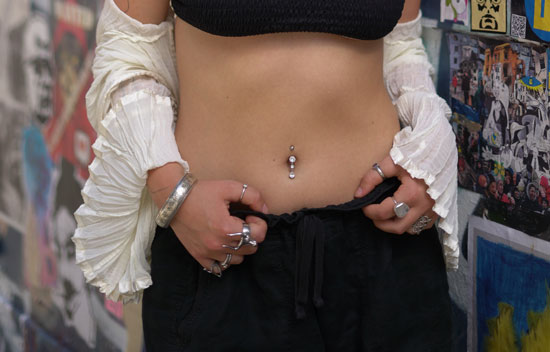Navel Piercings

Navel piercing, also known as belly button piercing, is a popular form of body piercing where a jewelry piece is placed through the skin above or around the navel. If you are considering getting a navel piercing, here are some important points to keep in mind:
1. Professional Piercer:
Choose a reputable and experienced professional piercer who follows strict hygiene and sterilization practices. Research their credentials, read reviews, and ensure they have a clean and safe environment.
2. Healing Time:
Healing time for navel piercings can vary but typically ranges from 6 to 12 months. During the healing process, it's important to follow proper aftercare instructions provided by your piercer, such as cleaning the piercing with a saline solution and avoiding any trauma or contact with unclean objects.
3. Pain and Sensitivity:
Navel piercings can be slightly painful during the piercing process and may cause temporary sensitivity, tenderness, and discomfort afterward. The level of pain varies for each individual, and over-the-counter pain relievers can help manage any discomfort.
4. Infection and Complications:
Like any piercing, there is a risk of infection and complications. Proper aftercare and maintaining good hygiene are crucial to minimize these risks. Look out for signs of infection, such as increased redness, swelling, discharge, or persistent pain, and seek medical attention if needed.
5. Jewelry Selection:
Choose jewelry specifically designed for navel piercings, made from hypoallergenic materials such as surgical stainless steel or titanium. Ensure that the jewelry is the appropriate size and style for your specific piercing.
6. Clothing and Irritation:
Consider the clothing you wear and how it may interact with the piercing. Tight clothing, particularly waistbands or belts, may rub against the piercing and cause irritation or discomfort. It's important to choose clothing that allows the piercing to breathe and heal properly.
7. Lifestyle Considerations:
Think about your lifestyle and activities that may come in contact with the piercing. For example, certain sports or activities that involve direct pressure or contact with the navel area may pose risks or discomfort. It's important to assess whether your lifestyle is compatible with a navel piercing.
8. Personal Style and Preference:
Navel piercings can be a stylish and fashionable form of self-expression. Consider whether a navel piercing aligns with your personal style and preferences.
Remember, navel piercing is a personal choice, and it's important to make an informed decision. Discuss your plans with a professional piercer who can provide personalized advice and address any concerns you may have.
 Mother's Day
Mother's Day Good Morning
Good Morning